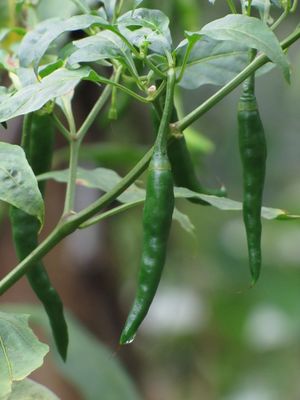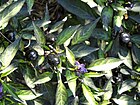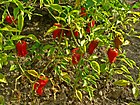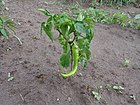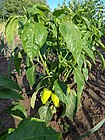Note: This is a project under development. The articles on this wiki are just being initiated and broadly incomplete. You can Help creating new pages.
Difference between revisions of "Capsicum annuum - Katphala"
(Created page with "thumb|right|''Green-chilli'' Category:Herbs '''Chilli''' is considered as one of the best spices used in Kitchen. Chillies are used in...") |
(→External Links) |
||
| (24 intermediate revisions by 4 users not shown) | |||
| Line 1: | Line 1: | ||
[[File:Green-chilli-in-Kannur.JPG|thumb|right|''Green-chilli'']] | [[File:Green-chilli-in-Kannur.JPG|thumb|right|''Green-chilli'']] | ||
| − | [[ | + | '''Capsicum''' is a popular species cultivated world wide. Despite being a single species, the capsicum annum has many forms, with a variety of names, even in the same language. |
| + | ==Uses== | ||
| + | {{Uses|Cold}}, {{Uses|Fever}}, {{Uses|Asthma}}, {{Uses|Digestive problems}}, {{Uses|Skin eruptions}}, {{Uses|Sprains}}, {{Uses|Unbroken chilblains}}, {{Uses|Neuralgia}}, {{Uses|Pleurisy}} | ||
| + | |||
| + | ==Parts Used== | ||
| + | {{Parts Used|Flowers}}, {{Parts Used|Fruits}}, {{Parts Used|Leaves}}. | ||
| + | |||
| + | ==Chemical Composition== | ||
| + | Capsaicin, a red colouring matter, oleic, palmitic and stearic acids<ref name="chemical composition"/> | ||
| + | |||
| + | ==Common names== | ||
| + | {{Common names|kn=|ml=|sa=|ta=|te=|hi=Shimla mirch|en=Capsicum, Sweet Pepper}} | ||
| + | |||
| + | ==Properties== | ||
| + | Reference: Dravya - Substance, Rasa - Taste, Guna - Qualities, Veerya - Potency, Vipaka - Post-digesion effect, Karma - Pharmacological activity, Prabhava - Therepeutics. | ||
| + | ===Dravya=== | ||
| + | |||
| + | ===Rasa=== | ||
| + | Katu | ||
| + | ===Guna=== | ||
| + | Laghu, Ruksha | ||
| + | ===Veerya=== | ||
| + | Ushna | ||
| + | ===Vipaka=== | ||
| + | Katu | ||
| + | ===Karma=== | ||
| + | Kapvata shamaka, Pitta vardhaka | ||
| + | ===Prabhava=== | ||
| + | |||
| + | ==Habit== | ||
| + | {{Habit|Stout herb}} | ||
| + | |||
| + | ==Identification== | ||
| + | ===Leaf=== | ||
| + | {{Leaf|Simple|Alternate|Elliptical to lanceolate, with smooth margins (entire)}}<ref name="Leaf"/> | ||
| + | |||
| + | ===Flower=== | ||
| + | {{Flower|Unisexual|Around 1.5 cm|Yellow|5|The small flowers are borne singly or, rarely, in pairs in the axils}} | ||
| + | |||
| + | ===Fruit=== | ||
| + | {{Fruit|Berries pod|7–10 mm (0.28–0.4 in.) long pome|Ripening to green, yellow, orange, red, or purple|But with no sutures—that vary considerably in size and shape|Many}} | ||
| + | |||
| + | ===Other features=== | ||
| + | |||
| + | ==List of Ayurvedic medicine in which the herb is used== | ||
| + | * [[Vishatinduka Taila]] as ''root juice extract'' | ||
| + | |||
| + | ==Where to get the saplings== | ||
| + | ==Mode of Propagation== | ||
| + | {{Propagation|Seeds}}. | ||
| + | |||
| + | ==How to plant/cultivate== | ||
| + | Capsicums (Capsicum annuum) and chillies (Capsicum frutescens) are cultivated as annual vegetables while the edible parts are botanically fruit.<ref name="How to plant/cultivate"/> | ||
| + | |||
| + | ==Commonly seen growing in areas== | ||
| + | {{Commonly seen|Landscape in vegetable gardens}}, {{Commonly seen|Landscape as cultivated}} | ||
| + | |||
| + | ==Photo Gallery== | ||
| + | <gallery class="left" caption="" widths="140px" heights="140px"> | ||
| + | Capsicum annuum - J. C. Raulston Arboretum -.JPG | ||
| + | |||
| + | Capsicum annuum 001.JPG | ||
| + | |||
| + | |||
| + | Capsicum annuum 002.JPG | ||
| + | |||
| + | |||
| + | Capsicum annuum 003.JPG | ||
| + | |||
| + | |||
| + | Capsicum annuum 01.JPG | ||
| + | |||
| + | |||
| + | Capsicum annuum 02.JPG | ||
| + | |||
| + | </gallery> | ||
| + | |||
| + | ==References== | ||
| − | + | <references> | |
| + | <ref name="chemical composition">[https://www.mdidea.com/products/new/new00504.html Phytochemicals and Constituents of Capsicum]</ref> | ||
| + | <ref name="Leaf">[http://eol.org/pages/581098/overview Brief summary of chillis]</ref> | ||
| − | = | + | <ref name="How to plant/cultivate">[https://www.agric.wa.gov.au/capsicums-and-chillies/growing-capsicums-and-chillies Growing capsicums and chillies]</ref> |
| + | </references> | ||
| − | + | ==External Links== | |
| − | + | * [https://www.worldofchillies.com/Chilli-plant-varieties/Chilli-plant-varieties-Capsicum/Chilli-plants-Capsicum-Annuum.html Hottest chillis around the world] | |
| − | + | * [https://plants.ces.ncsu.edu/plants/all/capsicum-annuum-longum-group/ Charecteristics of chillis] | |
| − | + | * [https://www.researchgate.net/publication/228489079_Chemical_composition_of_the_pepper_fruit_extracts_of_hot_cultivars_Capsicum_annuum_L CHEMICAL COMPOSITION OF THE PEPPER FRUIT EXTRACTS OF HOT CULTIVARS] | |
| − | + | * [http://www.missouribotanicalgarden.org/PlantFinder/PlantFinderDetails.aspx?kempercode=a685 Chillis on Missouri botonical garden] | |
| − | + | [[Category:Herbs]] | |
| − | + | [[Category:Ayurvedic herbs that don't have seed photos]] | |
| − | + | [[Category:Solanaceae]] | |
| − | |||
Latest revision as of 10:17, 9 April 2020
Capsicum is a popular species cultivated world wide. Despite being a single species, the capsicum annum has many forms, with a variety of names, even in the same language.
Contents
- 1 Uses
- 2 Parts Used
- 3 Chemical Composition
- 4 Common names
- 5 Properties
- 6 Habit
- 7 Identification
- 8 List of Ayurvedic medicine in which the herb is used
- 9 Where to get the saplings
- 10 Mode of Propagation
- 11 How to plant/cultivate
- 12 Commonly seen growing in areas
- 13 Photo Gallery
- 14 References
- 15 External Links
Uses
Cold, Fever, Asthma, Digestive problems, Skin eruptions, Sprains, Unbroken chilblains, Neuralgia, Pleurisy
Parts Used
Chemical Composition
Capsaicin, a red colouring matter, oleic, palmitic and stearic acids[1]
Common names
| Language | Common name |
|---|---|
| Kannada | |
| Hindi | Shimla mirch |
| Malayalam | |
| Tamil | |
| Telugu | |
| Marathi | NA |
| Gujarathi | NA |
| Punjabi | NA |
| Kashmiri | NA |
| Sanskrit | |
| English | Capsicum, Sweet Pepper |
Properties
Reference: Dravya - Substance, Rasa - Taste, Guna - Qualities, Veerya - Potency, Vipaka - Post-digesion effect, Karma - Pharmacological activity, Prabhava - Therepeutics.
Dravya
Rasa
Katu
Guna
Laghu, Ruksha
Veerya
Ushna
Vipaka
Katu
Karma
Kapvata shamaka, Pitta vardhaka
Prabhava
Habit
Identification
Leaf
| Kind | Shape | Feature |
|---|---|---|
| Simple | Alternate | Elliptical to lanceolate, with smooth margins (entire) |
Flower
| Type | Size | Color and composition | Stamen | More information |
|---|---|---|---|---|
| Unisexual | Around 1.5 cm | Yellow | 5 | The small flowers are borne singly or, rarely, in pairs in the axils |
Fruit
| Type | Size | Mass | Appearance | Seeds | More information |
|---|---|---|---|---|---|
| Berries pod | 7–10 mm (0.28–0.4 in.) long pome | Ripening to green, yellow, orange, red, or purple | But with no sutures—that vary considerably in size and shape | Many | {{{6}}} |
Other features
List of Ayurvedic medicine in which the herb is used
- Vishatinduka Taila as root juice extract
Where to get the saplings
Mode of Propagation
How to plant/cultivate
Capsicums (Capsicum annuum) and chillies (Capsicum frutescens) are cultivated as annual vegetables while the edible parts are botanically fruit.[3]
Commonly seen growing in areas
Landscape in vegetable gardens, Landscape as cultivated
Photo Gallery
References
External Links
- Ayurvedic Herbs known to be helpful to treat Cold
- Ayurvedic Herbs known to be helpful to treat Fever
- Ayurvedic Herbs known to be helpful to treat Asthma
- Ayurvedic Herbs known to be helpful to treat Digestive problems
- Ayurvedic Herbs known to be helpful to treat Skin eruptions
- Ayurvedic Herbs known to be helpful to treat Sprains
- Ayurvedic Herbs known to be helpful to treat Unbroken chilblains
- Ayurvedic Herbs known to be helpful to treat Neuralgia
- Ayurvedic Herbs known to be helpful to treat Pleurisy
- Herbs with Flowers used in medicine
- Herbs with Fruits used in medicine
- Herbs with Leaves used in medicine
- Herbs with common name in Hindi
- Herbs with common name in English
- Habit - Stout herb
- Index of Plants which can be propagated by Seeds
- Herbs that are commonly seen in the region of Landscape in vegetable gardens
- Herbs that are commonly seen in the region of Landscape as cultivated
- Herbs
- Ayurvedic herbs that don't have seed photos
- Solanaceae
